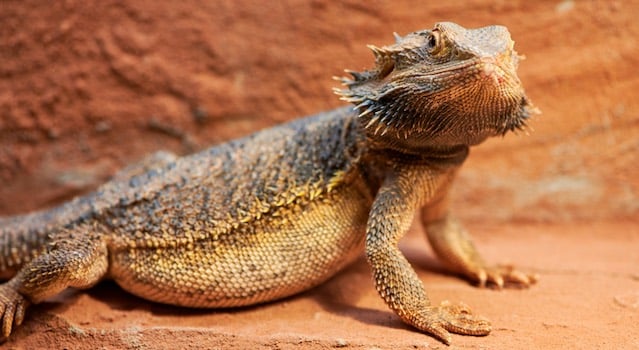
In This Article
- Introduction to Bearded Dragon Egg Laying
- Can Bearded Dragons Lay Eggs Without Mating?
- When to Expect Egg Laying
- Signs Your Bearded Dragon Has Eggs
- What to Do When You Suspect Eggs
- Post-Laying Recovery
- Expecting More Clutches
- When to See a Vet
- What to Do with the Eggs
- Conclusion
Introduction to Bearded Dragon Egg Laying
Bearded dragons are egg-laying, oviparous reptiles, with females capable of laying eggs every 4-6 weeks during breeding season. Egg-laying is a normal part of a female bearded dragon’s life, even if she has never been with a male. As a responsible keeper, it’s essential to familiarize yourself with the egg-laying process, how to prepare for it, and how to care for your bearded dragon post-laying.
This article will tell you everything you need to know about bearded dragon egg laying.
Can Bearded Dragons Lay Eggs Without Mating?
If you thought female bearded dragons need a male to lay eggs, you might be surprised to learn this is false. Like chickens, female bearded dragons can lay infertile eggs without ever having been with a male. These eggs are infertile and therefore will not hatch into baby bearded dragons.
Infertile eggs will look different than fertile eggs. They are typically slightly yellow and dented. If they aren’t removed quickly enough, they can begin to rot, causing them to smell bad and create an ideal environment for harmful bacteria and other pathogens to grow.
Not all females lay eggs; some may only lay once, while others lay more often. Egg-laying can be unpredictable and varies from dragon to dragon. Regardless, every keeper should understand this aspect of female bearded dragon care.
If you have a male dragon, you won’t have to worry about them laying eggs. However, it’s still interesting to learn about these reptiles’ egg-laying abilities.
When to Expect Egg Laying
Age of Sexual Maturity
Female bearded dragons typically lay eggs when they are sexually mature, commonly at around 12 months of age. However, it can begin as early as 6-8 months, although this is rare. Furthermore, some females may only lay eggs after 18 months of age. Several factors can affect egg laying, including body condition, diet, and environmental conditions.
Ideal Weight for Female Bearded Dragons
The average weight for female bearded dragons is about 14.1 ounces (400 grams) or less. This can vary depending on her age, genetics, and size, but anything typically over 18 ounces (510 grams) is considered obese. A healthy diet and regular exercise can help keep your female dragon within a healthy weight range and prevent weight-related reproductive issues.
Body Condition and Egg Laying Risks
Body condition, such as being overweight, can increase the risk of follicular stasis in females. This is a relatively common reproductive disorder in female dragons, and it can be fatal if left untreated. The main signs of follicular stasis include sudden weight loss, lethargy, abdominal swelling, and yolk coelomitis (ruptured follicle). The underlying issue for this health problem occurs when the follicles (pre-eggs) fail to ovulate and develop properly.
The Role of Diet in Egg Production
Diet is another major factor for egg production. Females with a healthy diet are more likely to have better egg-laying cycles. Calcium and vitamin D3 are essential for healthy egg-laying. Calcium is vital for maintaining strong bones and producing healthy eggs. Vitamin D3 is essential for proper calcium absorption; otherwise, the egg shells may be soft and poorly developed.
Preventing Calcium Deficiencies
Calcium deficiencies can cause soft egg shells, weakened bones, dystocia (egg-binding), and put them at risk of metabolic bone disease (MBD). Make sure your female bearded dragon has calcium and vitamin D3 supplements in addition to a balanced diet to prevent health issues and reproductive problems linked to nutritional deficiencies. A UVB light is also necessary for proper calcium absorption and to prevent calcium deficiencies.
Signs Your Bearded Dragon Has Eggs
- Weight Gain: Noticeable weight gain, especially around the abdomen, without changes in diet or routine.
- Changes in Appetite: Increased or decreased appetite depending on how close she is to laying her eggs. An increase in appetite is usually noticed in the early stages of egg development. A few days before she starts laying, she may eat less than usual or refuse food entirely.
- Visible Eggs: You may notice a larger belly than usual with visible egg shapes along the sides and belly.
- Behavioral Signs: Changes in behavior are common, including increased restlessness, irritability, or a decrease in activity levels as she approaches laying eggs. Her typical behavior should return shortly after she lays the eggs.
- Digging Behavior: Trying to find a nesting spot to lay her eggs.
What to Do When You Suspect Eggs
If you suspect your bearded dragon has laid eggs, here’s what to do:
Boost Calcium Intake
Bearded dragons need significant amounts of calcium to produce eggs with strong, healthy shells. As previously discussed, calcium deficiencies can lead to soft-shelled eggs or egg binding, making calcium essential for egg development.
You can boost their calcium intake by regularly dusting feeder insects and salads with a calcium and vitamin D3 supplement up to three times a week. Make sure she also has access to UVB lighting for 10-12 hours per day.
Set Up a Lay Box
You should also prepare a lay box where she can comfortably and securely lay her eggs. In the wild, females burrow in damp soil to lay their eggs, so this environment should be replicated in captivity.
The lay box should be placed on the cool side of the enclosure and have a deep layer of damp play sand or an organic soil/sand mix. The substrate should be at least 6-8 inches (15-20 cm) deep and moist enough to hold its shape when dug into.
Female bearded dragons prefer privacy during egg laying, so it’s recommended to cover part of the enclosure, ideally the area with the lay box. Additionally, ensure that the temperature and humidity levels are maintained within an optimal range.
During the Laying Process
It’s essential to be patient during the laying process; it can take up to a week to complete. A normal clutch size typically consists of 20 to 30 eggs. Most bearded dragons do not care about their eggs, so it is not necessary to keep them in the enclosure. Once your female has finished laying the eggs, covered them, and has left the laying box, you can remove the lay box.
Post-Laying Recovery
Egg laying requires a lot of energy, so it’s normal for females to have lower activity levels shortly after. This is why it’s a good idea to let her rest for 12 hours before offering food and interacting with her.
After rest, you can begin offering small amounts of calcium-dusted insects and greens. You don’t want to overfeed, so make sure to gradually resume feeding and supplementing until her appetite and behavior return to normal.
Hydration is also essential during this time, so ensure her water dishes have fresh water available for her to drink.
Expecting More Clutches
Some females may lay more than one clutch in a season. Typically, they lay eggs once every 4-6 weeks, although this isn’t the case for every female. If she does lay more than one clutch, all you need to do is repeat the lay box setup and post-lay care each time. And, of course, continue to monitor her behavior and weight.
When to See a Vet
You should take your female bearded dragon to a knowledgeable reptile veterinarian if you notice any of these signs:
- Displays signs of egg-laying but isn’t laying.
- Appears to be struggling or lays very few eggs.
- Multiple attempts to lay eggs, but only pass a few each time or none at all.
- An abnormally swollen belly that is affecting her breathing or movement.
- A lack of appetite.
- Lethargy, weakness, or sluggish movements.
These are signs that something is wrong, possibly egg binding or follicular stasis, both of which can be fatal without prompt veterinary treatment.
What should you do if you notice these signs?
- Do NOT massage her belly as this can cause egg rupture.
- Take her to a vet to scan for retained eggs. They will recommend the following steps, whether the situation requires medical attention or surgery.
What to Do with the Eggs
If the eggs are infertile, you can discard them in a Ziplock bag and dispose of them. An outdoor bin is ideal because the eggs can start to smell bad when they begin to rot. Fertile eggs should be incubated in a reptile incubator with the proper substrate, temperature, and humidity levels. These eggs should hatch within 55 to 75 days, depending on certain factors.
If you are unsure if the eggs are fertile, you can use the flashlight or candle method to check. All you need is a phone flashlight or candle and a dark room. If you hold the light up to the egg and see a pink embryo inside, the egg is most likely fertile. If the egg doesn’t have an embryo and appears dented and yellow-colored, the egg is probably infertile and can be discarded.
Conclusion
Egg laying is a natural, albeit sometimes stressful, part of caring for female bearded dragons. Females can lay eggs even if they are never kept with a male in clutches of 20-30 eggs.
The main signs to watch out for include changes in appetite, sudden weight gain without dietary changes, and a larger belly with visible eggs. You should be observing them closely for signs that something is wrong and be prepared with the correct setup.
And lastly, seek vet care if you’re unsure about the egg-laying process or notice something concerning, like lethargy or difficulty laying.



